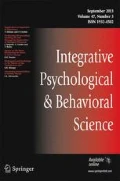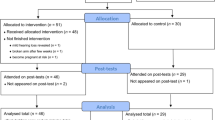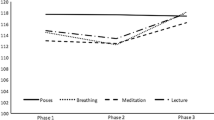Abstract
The study aimed at determining whether novices to yoga would be able to reduce their heart rate voluntarily and whether the magnitude of reduction would be more after 30 days of yoga training. Two groups (yoga and control,n=12 each) were assessed on Day 1 and on Day 30. During the intervening 30 days, the yoga group received training in yoga techniques while the control group carried on with their routine. At each assessment the baseline heart rate was recorded for one minute, this was followed by a six-minute period during which participants were asked to attempt to voluntarily reduce their heart rate, using any strategy. Both the baseline heart rate and the lowest heart rate achieved voluntarily during the six-minute period were significantly lower in the yoga group on Day 30 compared to Day 1 by a group average of 10.7 beats per minute (i.e., bpm) and 6.8 bpm, respectively (p<.05, Wilcoxon paired signed ranks test). In contrast, there was no significant change in either the baseline heart rate or the lowest heart rate achieved voluntarily in the control group on Day 30 compared to Day 1. The results suggest that yoga training can enable practitioners to use their own strategies to reduce the heart rate, which has possible therapeutic applications.
Similar content being viewed by others
References
Benson, H., Lehman, J.W., Malhotra, M.S., Goldman, R.F., Hopkins, J., & Epstein, M.D. (1982). Body temperature changes during the practice of g-Tum-mo yoga.Nature, 295, 234–235.
Furedy, J.J., & Riley, D.M. (1982). Classical and operant conditioning in the enhancement of biofeedback: specifics and speculations. In L. White & B. Tursky (Eds.),Clinical Biofeedback: efficacy and mechanisms. (pp. 74–102). New York: Guilford.
Furedy, J.J. (1987). Specific versus placebo effects in biofeedback training: a critical lay perspective.Biofeedback and Self-Regulation, 12, 169–184.
Furedy, J.J., Shulhan, D., & Randall, D.C. (1989). Human Pavlovian HR decelerative conditioning with negative tilt as US: a review of some S-R, stimulus-substitution evidence.International Journal of Psychophysiology 7, 19–23.
Kothari, L.K., Bordia, A., & Gupta, O.P. (1973). The yogic claim of voluntary control over the heartbeat: an unusual demonstration.American Heart Journal, 86, 283–284.
Leukel, F. (1985).Introduction to Physiological Psychology. Indian edition. Delhi: CBS Publications.
Manjunath, N.K., & Telles, S. (1999). Factors influencing changes in tweezers dexterity scores following yoga training.Indian Journal of Physiology and Pharmacology, 43(2), 225–229.
Mehta, R. (1990).Yoga: The art of integration. Madras: The Theosophical Publishing House.
Neumann, C., & Schmid, H. (1997). Standardization of a computerized method for calculating autonomic function test responses in healthy subjects and patients with diabetes mellitus.Brazilian Journal of Medical and Biological Research, 30(2), 197–205.
Papillo, J.F., & Shapiro, D. (1990). The cardiovascular system. In J.T. Cacioppo & L.G. Tassinary (Eds.),Principles of psychophysiology, (pp. 456–512). Cambridge: Cambridge University Press.
Siche, J.P. (1998). Factors of variation in heart rate.Annales de Cardiologie et d'angeiologie, 47(6), 415–419.
Taimini, I.K. (1986). TheScience of Yoga. Madras: The Theosophical Publishing House.
Telles, S., Hanumanthaiah, B., Nagarathna, R., & Nagendra, H.R. (1993). Improvement in static motor performance following yoga training of school children.Perceptual and Motor Skills, 76, 1264–1266.
Telles, S., Narendran, S., Raghuraj, P., Nagarathna, R., & Nagendra, H.R. (1997). Comparison of changes in autonomic and respiratory parameters of girls after yoga and games at a community home.Perceptual and Motor Skills, 84, 251–257.
Telles, S., & Srinivas, R.B. (1999). Autonomic and respiratory measures in children with impaired vision following yoga and physical activity programs.International Journal of Rehabilitation and Health, 4(2), 117–122.
Telles, S., & Vani, R. (2002). Increase in voluntary pulse rate reduction achieved following yoga training.International Journal of Stress Management, 9(3), 235–239.
Wenger, M.A., Bagchi, B.K., & Anand, B.K. (1961). Experiments in India on ‘voluntary’ control of the heart and pulse.Circulation, 24, 1319–1325.
Author information
Authors and Affiliations
Corresponding author
Rights and permissions
About this article
Cite this article
Telles, S., Joshi, M., Dash, M. et al. An evaluation of the ability to voluntarily reduce the heart rate after a month of yoga practice. Integr. psych. behav. 39, 119–125 (2004). https://doi.org/10.1007/BF02734277
Issue Date:
DOI: https://doi.org/10.1007/BF02734277




